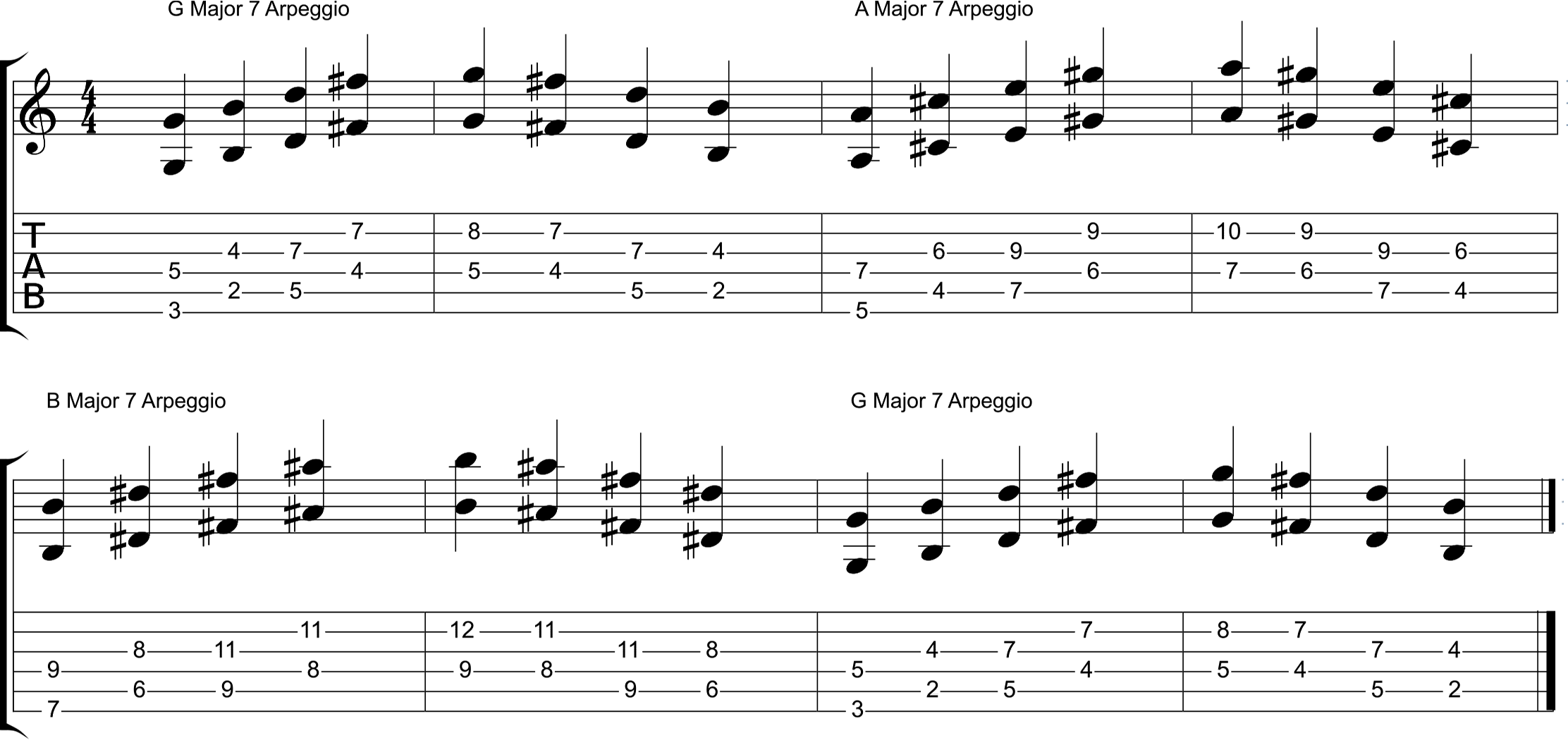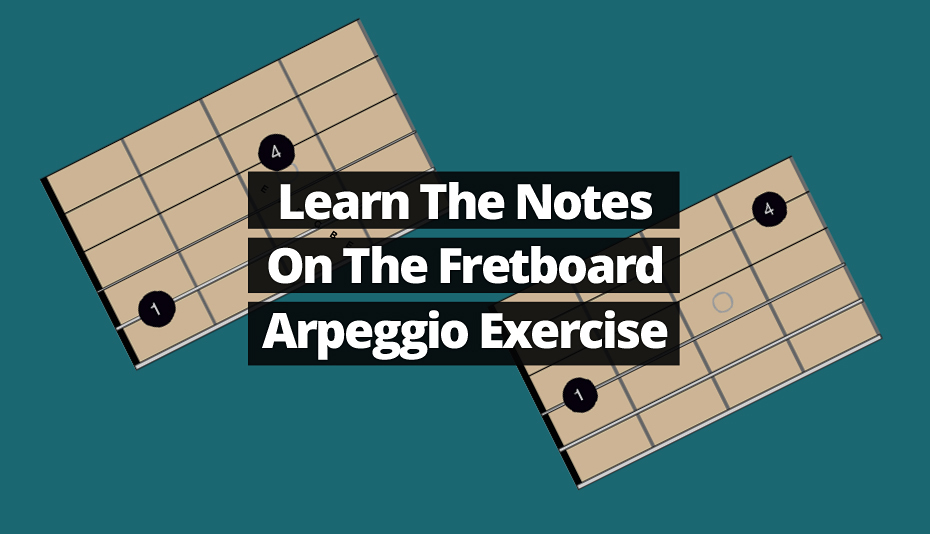This arpeggio octave shape exercise will help you learn the guitar fretboard notes quickly & increase finger speed (+ FREE guitar backing tracks!)
- You’ll also dig: Learn the Guitar Fretboard in Just 5 Steps (5-Step Memory Method)
- Excerpt taken from Easy Peasy Guitar Music Theory: for Beginners book
Table of Contents
Want to learn the fretboard notes fast? Try this simple octave shape trick!
Before we get to the exercises, let’s learn what an octave shape is.
What is an Octave Shape?
Octave shapes are a powerful tool for guitarists of all levels. They can help you to learn the fretboard, improve your technique, and develop your improvisational skills.
One of the great things about octave shapes is that they can be used to craft better guitar solos. When you know the different octave shapes, you can easily move from one note to another, regardless of where it is on the fretboard.
This gives you the freedom to explore the fretboard and create melodic lines that are both interesting and technically impressive.
Octave shapes can also be used to find chords all over the neck of your guitar. This means you can play chords in any key and position, making your playing more versatile and expressive.
Pro Tip
If you're serious about improving your guitar playing, I highly recommend learning the different octave shapes. They're a valuable tool that can help you to reach your full potential as a musician.
Octave Shape Trick – Arpeggio Exercise
The following drill is an arpeggio sequence where you play the note intervals that make up a Major 7th chord (1-3-5-7) using octave shapes instead of single notes.
What is a major 7th chord?
A major 7th chord is a four-note chord consisting of a root note, a major third, a perfect fifth, and a major seventh. It is one of the most common chords in Western music and is often used in jazz, blues, and rock.
The major 7th chord is constructed by adding a major seventh interval to a major triad. For example, a C major 7th chord is made up of the notes C, E, G, and B.
Major 7th chords have a bright and cheerful sound. They are often used to create a sense of excitement and anticipation in music.
Tools to use:
Metronome, timer, phone or tablet to record progress clips, notepad for practice notes, blank tablature paper to keep a log of any variations to add in.
Check out the fig. 1.0 TAB diagram below and start by practicing the G major arpeggio. Once you’ve mastered that, you can move on to the A and B keys.
It’s best to focus on one position at a time to make things easier on yourself.
Exercise Goals:
Use a metronome on 60-70-bpm once your fingers start getting to the positions easier and gradually increasing speed. Focus on getting the notes clean, buzz-free and in perfect time.
When you’re practicing, avoid speeding up and slowing down. I know it can be tough at first, but keep working on it and you’ll get there.
To make practicing more fun, check out the free backing tracks at the bottom of this post. These tracks will help you turn your exercises into actual music.
Fingers to use:
To play this arpeggio shape, place your 1st finger on the lower-pitched note and use your 4th pinky finger on the higher note.
It’s best to avoid using your third finger on the upper note, not because it’s incorrect but because many players tend to neglect their little finger, which can lead to weakness and ineffectiveness.
Let’s avoid that. The span from your first finger to your fourth is also wider, which is an added bonus.

Pro Tip
Say the notes out loud as you play each shape. This is known as 'acoustic encoding' and is a clever memorisation technique that turbo boosts learning of new information.
How to Practice Your Octave Shape Arpeggios More Effectively
Here are five ways to improve your octave shape arpeggio playing by changing up your practice routine:
→ Tempo: Use a metronome and gradually increase the speed as you get more comfortable. This will help you develop solid timing.
Try these three speeds: Slow (60bpm approx), moderate (90bpm approx), fast (140bpm approx). Adjust the moderate and fast speeds according to your ability level and how brave you feel. 😉
→ Duration: Set a timer and practice for different lengths of time, such as 60 seconds or 2 minutes. This will help you build endurance and focus.
→ Number of reps: Don’t just repeat the same thing over and over again. Change up the number of repetitions you do for each exercise, section, or key. This will help you stay challenged and avoid boredom.
→ Rhythm: Experiment with different rhythms, such as quarter notes, eighth notes, sixteenth notes, and triplets. This will help you develop your rhythm skills and make your playing more interesting.
→ Music theory: As you play, try to identify the notes and intervals you’re playing. This will help you learn the fretboard better and understand the music you’re playing on a deeper level.
Does your music theory need a brush-up? Check out my beginner book that’ll help you understand the guitar music theory basics you 100% need to know.
Free Practice Backing Tracks
The practice variations in “How to Practice Your Octave Shape Arpeggios More Effectively” can help you come up with new and interesting ways to play arpeggios over the following backing tracks.
Backing Track No. 1
This is a 90bpm G major 7th chord vamp rhythm track. Practice the Gmaj7th octave shape arpeggio exercise over it. ⇩
Backing Track No. 2
This backing track is an A major 7th rhythm track at 90bpm. Practice the Amaj7th octave shape arpeggio exercise over this. ⇩
Backing Track No. 3
This third backing track is a B major 7th chord rhythm track at 90bpm. Practice the Bmaj7th octave shape arpeggio exercise over this. ⇩
Backing Track No. 4
This next backing track moves through the progression of the Gmaj7th – Amaj7th -Bmaj7th chords at 90bpm. Each key is played for 4 bars. Practice changing smoothly through the corresponding octave shape arpeggios over this track. ⇩
Backing Track No. 5
This next backing track moves through the progression of the Gmaj7th – Amaj7th -Bmaj7th chords at 115bpm. ⇩
Backing Track No. 6
This next backing track moves through the progression of the Gmaj7th – Amaj7th -Bmaj7th chords at 140bpm. ⇩
Summing it Up
Practicing octave shape arpeggios is a great way to improve your fretboard mastery and develop your improvisational skills.
Following the tips in this blog post can make your practice more effective and enjoyable.
Here is an interesting challenge for you: try playing octave shape arpeggios in all 12 keys. This will help you to learn the fretboard inside and out and give you a solid foundation for improvisation.
Have fun rockstars!









